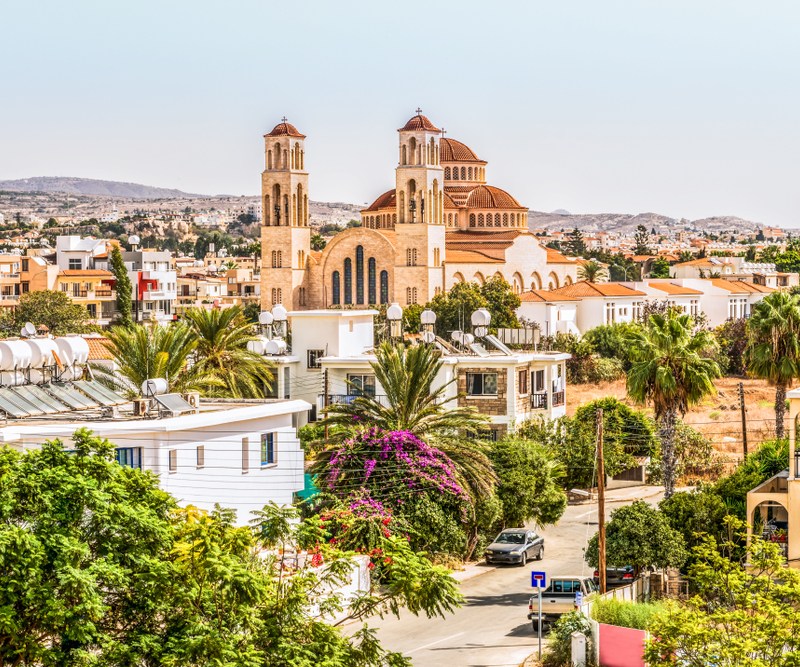
Cyprus is one of the best holiday spots in the Mediterranean Sea. Europeans flock there to get their sun, surf, and even skiing, but it’s still relatively unknown to travelers from the United States.
Videos by TravelAwaits
Here are seven reasons why this small island nation — perhaps best known as the legendary birthplace of the Greek goddess Aphrodite — should be on your travel bucket list.

1. The Climate
The incredible weather on Cyprus tops our list of reasons to travel there. Located 50 miles south of the Turkish coast in the far eastern Mediterranean, the island straddles Europe and Asia and enjoys a temperate subtropical climate. Mild winters and dry, warm summers ensure there’s no bad time of year to visit.
While you’ll likely find the temperatures a bit too chilly to sunbathe in January or February (highs in the low 60s), it will likely feel more like autumn to you than winter. Snow is rare, except for in the Troodos Mountains, where there’s just enough to ski at the very top of Mount Olympus (6,401 feet and the island’s highest point), about an hour’s drive west of the capital city, Nicosia.
The bottom line: Layer up with long sleeves and perhaps a fleece during the winter, and pack light, cool clothes for the summer, when temperatures can rise to nearly 90 degrees. Either way, get ready to enjoy gorgeous Mediterranean weather that’s probably balmier and more delightful than what you’re used to, no matter the time of year!
2. The Beaches
Of course, being an island, Cyprus is well known for its beaches. Whether you’re satisfied with a cocktail, sun, and surf or are a more adventurous beachcomber looking for a challenge, Cyprus’s offerings will not disappoint.
One of the more famous stretches of sand on the island is Nissi Beach, located on the resort that shares its name. This area’s soft white sand and bright, azure waters make the area a favorite for tourists and locals alike.
Not too far from Nissi Beach is Konnos Bay, a 660-foot stretch that’s terrific for swimming because of its gentle waves. This is a spot Cypriots love, and there are cafés and convenience stores nearby where you can grab a drink or snack.
If you’re in the mood to spot some wildlife, head to Lara Beach in a secluded area of the Paphos District. This quiet, gorgeous beach is accessible only by off-road vehicle or hike, and it’s the spot where green sea turtles come ashore to lay their eggs.
Of course, you must at least drive by Aphrodite’s Rock, an outcrop just off the coast where legend has it that the Greek goddess of love, Aphrodite, emerged from the sea. The beach is popular with tourists, who come to swim in its mystical waters.

3. The History
The history of Cyprus is long, complicated, and marked by many different empires and regimes, but that’s part of what makes this island a fascinating vacation destination.
Over the millennia, the island was considered a strategic must-have, and thus was constantly conquered. The Assyrians, Egyptians, Persians, Venetians, Crusaders, the Ottoman Empire, and the British all occupied Cyprus. Each group left its mark on the island, from the Tomb of the Kings, a UNESCO World Heritage site that dates back to the Hellenistic period, to the Saint Hilarion Castle that was written about by Richard the Lionheart during his Crusades campaign in 1191.
You won’t want to miss the amazingly preserved Roman floor mosaics at Kourion in Limassol and Paphos.
To get a feel for the Muslim influence on the island, visit the tomb and mosque of Umm Haram (Hala Sultan Tekke), the maternal aunt of the prophet Muhammad. The mosque standing today was built over Umm Haram’s grave; she arrived on Cyprus during the Arab raids led by Syrian forces in A.D. 647.
The walled capital city of Nicosia is the heart of the Turkish Cypriot community. Its bastions were built in the mid-16th century by the Venetians, and wandering through the city feels like taking a trip back in time.
To check out a curated collection that tells the story of the nation through artifacts and exhibits, head to the Cyprus Museum. The museum was founded in 1888 and designed to protect the treasure trove of archeological artifacts that have been found (and are still being found) on this fascinating island.
4. The Culture
Today, the people of Cyprus mostly fall into one of two major ethnic groups: the Greeks and the Turks. The island was divided into a Greek southern side and a Turkish northern side after a failed coup and military offensive in 1974.
Today, while the island is considered a republic run by the Greeks, each side has its own economy. The island’s official currency is the euro, and while Greek and Turkish are both official languages of the island, English is widely spoken and used on street signs and elsewhere.
Cypriots are typically either Greek Orthodox or Sunni Muslim. In both cultures, hospitality is of the utmost importance, so guests feel quite welcome.
Celebrations are also central to Cypriot culture; they are vibrant and often include folk music, dance, and art. A great way to experience the traditions of this special place is to participate in the annual Limassol Carnival. Held each year during Mardi Gras, it features parades, concerts, dancing, singing, and general merrymaking.

5. The Food
Freshness is key to the island’s cuisine: Seafood of all kinds, including fish, squid, and shellfish, are on offer daily. Fruits and vegetables are common ingredients in traditional foods. The cuisine is quite similar to Greek cuisine, but it also features French, Italian, and Middle Eastern influences.
Popular mezes — or appetizers — include hummus, taramosalata (fish roe dip), olives, tzatziki, and a variety of fresh salads. You’ll find delicious halloumi — a rich sheep’s milk cheese that can be served sliced, grilled, fried, or fresh — on nearly every café and taverna menu on Cyprus. Kebabs, lamb chops, gyros, and koftas (meatballs) are all popular main dishes, and desserts typically feature nuts, fruit, and sweet syrup or honey.
You will not go hungry on Cyprus, and the best meals tend to be the simplest. Grab a seat at a seaside café and order a meze platter, fresh fish, or the special of the day. You won’t be disappointed.
6. The Hidden-Gem Feel
While it’s a well-known European holiday spot, Cyprus isn’t quite as well known in other parts of the world. Ask your friends if they’ve heard of Cyprus, and chances are, they probably haven’t; it usually isn’t mentioned alongside other Mediterranean destinations like Greece and Italy. The island still feels like a hidden gem, and it isn’t swamped with tourists, especially in the autumn when the summer sun-seekers have left.

7. The Accessibility
Cyprus is surprisingly easy to get to from Europe’s major air hubs; reasonably priced flights to the island abound from regional European carriers as well as larger ones, including British Airways.
Once you land, you can opt to rent a car or try out the bus system, which is cheap, punctual, and heads to the island’s major cities and towns. Taxis are also readily available.
One thing to keep in mind: While there are open borders between the northern and southern portions of the island, there are a couple of rules you must follow. Have your passport ready to be checked. While you’re allowed to bring a car rented in the south to the north, the same doesn’t apply for cars rented in the north. You’ll need to leave your car at the border, but there are rental companies at the checkpoints where you can get another. Your hotel or resort can further advise you on the particulars of crossing what the locals call “the green line.” Don’t let this technicality stop you from enjoying both distinct and wonderful sides of the island, however.
8. The People
We saved the best for last. The Cypriot people, no matter what side of the island they call home, are warm, welcoming, laid-back, and generous hosts, happy to share their home with the visitors who venture there. Whether you’re enjoying a cup of coffee, a bite to eat, or a beach stroll, you’ll encounter a relaxed atmosphere and many smiles and heartfelt ya su (“good health”) greetings. Get ready to engage, have a chat, and make new friends.

